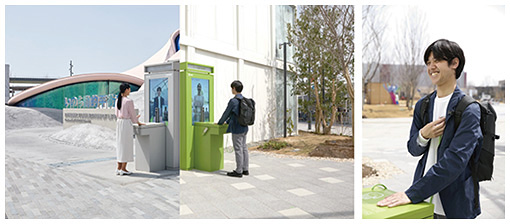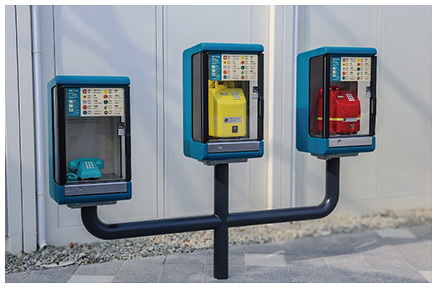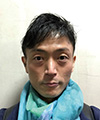 |
|||||||||||||||||
|
|
|||||||||||||||||
|
Feature Articles: NTT R&D at Expo 2025 Osaka, Kansai, Japan Vol. 23, No. 10, pp. 33–38, Oct. 2025. https://doi.org/10.53829/ntr202510fa3 Questioning the Nature of Communication through the “Fure-au Denwa” and “Denwa for Listening to the Universe” Exhibits—From the Telephone to Vibrotactile Communication MediaAbstractSituated outdoors in the NTT Pavilion area at Expo 2025 Osaka, Kansai, Japan were two key exhibits: “Fure-au Denwa” that enabled people to convey each other’s presence through vibrotactile sensations and “Denwa for Listening to the Universe,” where people could listen to stories about person-to-person communication. Fure-au Denwa shared vibrations through low-latency communications powered by NTT’s Innovative Optical and Wireless Network (IOWN) so that people could experience a new way of interacting through the sense of touch. Denwa for Listening to the Universe featured a retro-style telephone that visitors could use to listen to stories of how people have used the phone to connect with each other. These were exhibits experienced hands-on as media enabling past and future forms of communication. Keywords: Expo 2025 Osaka, Kansai, Japan, future communication, IOWN 1. 125 years from the first public telephones to vibrotactile communication media of the futureExpo 2025 Osaka, Kansai, Japan (hereafter referred to as Expo 2025) opened its doors on April 13 and closed on October 13, 2025. With the theme of “Designing Future Society for Our Lives,” Expo 2025 presented new technologies and values that will transform society and the way that people live their lives. NTT exhibited two types of communication media. One was remote vibrotactile communication media called “Fure-au Denwa” (where “fure-au” corresponds to “haptic interaction” and “denwa” to “telephone” in Japanese) that enabled people to communicate with each other through vibrotactile sensations in addition to audio and video. The other was “Denwa for Listening to the Universe” that enabled visitors to use the receiver of a retro-style telephone to listen to nostalgic stories of people using the phone to connect with each other. This year marks the introduction of public telephones in Japan exactly 125 years ago. In 1900, the first public telephones installed in Tokyo connected the thoughts of many people as a communication infrastructure in public spaces. Following in the footsteps of that history, Fure-au Denwa aimed to facilitate new forms of communication such as chance encounters in public spaces and vibrotactile communication when meeting someone for the first time. Denwa for Listening to the Universe, meanwhile, enabled visitors to relive past forms of communication by listening carefully to stories of people meeting and resonating with each other. In short, it provided visitors with the opportunity to relive the abundant ways that people have connected with each other through communication media. 2. Connecting to the future through Fure-au DenwaFure-au Denwa began from the theme “Creating the Phone of the Future.” In this regard, “Telephones of the Future” as a theme at Expo ’70 held in Osaka in 1970 mainly referred to the evolution of functionality by making the fixed telephone wireless and adding portability. Today, however, as communication technologies have matured, a substantial change is occurring in needs—instead of more and more functions and data capacity, the focus has turned to achieving “rich and heartfelt connections.” Against the above background, we have arrived at the concept of “from the telephone to interactive vibrotactile media.” That is to say, we aim to drive the evolution of the telephone from its conventional role of a tool for conveying information to one of interactive vibrotactile media that conveys the presence of the other party. Instead of simply exchanging words, this means delivering an intuitive feeling of “now we are connecting” by feeling vibrations or heartbeats of the other person in the palms of one’s hands. Incorporating vibrotactile sensations in this way can nurture connections that include trust, empathy, and “true feelings” beyond just the exchange of information. Fure-au Denwa is the archetype of this form of future communication—it will connect future paths for making person-to-person and heart-to-heart connections. 3. Vibration transmission technologyAt NTT laboratories, we have been focusing on the sense of touch shared by all people in our research on information communication technology that enables tactile sensations to be experienced in addition to conventional communication based on video and audio [1]. Through this form of physical communication, we aim to achieve a new experience that deepens person-to-person connections that can be intuitively felt. The sense of touch includes sensations such as temperature, pressure, and vibration. Fure-au Denwa deals, in particular, with vibration. Vibration information is transmitted by handling it as time-series waveform data, the same as audio data. On delivering such vibration waveform data to a device, a built-in vibrator operates according to that waveform, thus conveying that vibration to the receiver’s palms as a real tactile sensation. Fure-au Denwa is remote vibrotactile communication media that can bidirectionally exchange video, audio, and vibration as three types of information. With Fure-au Denwa, a user touches a table or panel with round hand marks. That action is measured in real time, converted into an audio waveform as a vibrotactile sensation, and transmitted to the other user via NTT’s Innovative Optical and Wireless Network (IOWN). On the receiving side, a vibrator is then activated in the same way to reproduce the waveform as a vibration, making the users feel as if they are actually touching each other. In this way, Fure-au Denwa achieves a new form of communication that enables physical sensations to be shared even at a distance. 4. Fure-au Denwa: Making connections through vibrotactile transmission technology powered by IOWNWhat makes Fure-au Denwa’s real-time vibrotactile experience possible is IOWN, a next-generation communication infrastructure developed by NTT [2]. The concept behind IOWN is to create a prosperous society using advanced optical technologies. Compared with conventional networks, IOWN boasts extremely low latency and high data-transfer performance. Taking for example interaction in which two people touch each other at the same time as when giving a high-five, IOWN makes it possible to feel like the other person you are touching is right in front of you without any time lag. The moment you make that contact, you can truly feel the other person’s presence. In conventional tactile communication, network delay becomes a barrier to real-time interaction. The introduction of IOWN that overcomes this barrier has made it possible to reproduce a sense of presence as in “I feel like I’m there right now.” In fact, visitors who experienced playing rock-papers-scissors or giving a high-five using Fure-au Denwa expressed surprise that such communication could be performed without any time lag. 5. Two concepts of connected through Fure-au DenwaTwo concepts of Fure-au Denwa were exhibited at Expo 2025. Each exhibit was located at a different location with a design to suit the significance and atmosphere of that location. These exhibits provided visitors with a variety of vibrotactile interactive experiences. First, the High-Five with Fure-au Denwa exhibit (Fig. 1) featured one monitor each at the Japan Pavilion and Kansai International Airport. This setup enabled overseas visitors arriving at Kansai International Airport and visitors at the Japan Pavilion of Expo 2025 to exchange greetings and give each other a high-five with Fure-au Denwa and to share those vibrations. The monitors on both sides were each designed with round hand marks. Touching those marks transmitted vibrations to the other person and lit up the hand marks on the other side at the same time. Language barriers could therefore be overcome and the feeling of giving a high-five could be mutually conveyed.
Even when meeting someone for the first time, vibration transmitted to one’s palms enables two people to feel each other’s presence in a natural way. This kind of vibrotactile exchange enabled visitors at the Japan Pavilion to show concern for people “on the other side” and gave visitors arriving at the airport a feeling of welcome while heightening their expectations of Expo 2025. Communication through tactile sensations can also be enjoyed in a nonverbal manner thereby overcoming language barriers and enabling all kinds of people to connect with each other. Next, the Life with Fure-au Denwa exhibit (Fig. 2) connected the NTT Pavilion and the Dynamic Equilibrium of Life signature pavilion produced by biologist Dr. Shin-ichi Fukuoka, which was also situated within Expo 2025. This exhibit enabled visitors to share not only tactile sensations but heartbeats too. In the exhibit, a table was installed in front of each monitor, and when a visitor on one side placed his or her hand on the table, that tactile sensation was conveyed to the table at the monitor on the other side as vibration. When sending that vibration, the hand mark on the other visitor’s table lit up signaling by visual means that information was sent.
A stethoscope-type microphone was also installed at the monitor on the NTT Pavilion side. When placed against your chest, this device measured your pulse and delivered it as a heartbeat to the table on the other side. Your heartbeat could also be felt as vibration at your own table. A heartbeat transmitted to another user’s palm in this way enabled that user to feel the other person’s “life.” This exhibit therefore helped users understand through physical means that each person’s existence comes alive through relationships with other people. 6. Genealogy of vibrotactile communication connected by past researchAn accumulation of physical media research conducted over many years by NTT lies in the background of Fure-au Denwa. The Public Booth for Vibrotactile Communication [3] exhibited at the NTT InterCommunication Center (ICC) [4] from 2019 on was an attempt to reproduce face-to-face interaction by adding vibrotactile information to video and audio. As media integrating a curved monitor and table, this booth provided remotely located users with the sensation of being together in the same place. It created a space in which even people meeting for the first time could proactively interact with each other. The stethoscope-type device used at the Life with Fure-au Denwa exhibit is based on Heart Box technology used in a workshop called “Heartbeat Picnic” [5, 6]. This box converts heartbeats obtained with the stethoscope placed against one’s chest to vibrations, and by exchanging boxes, a group of people can convey a presence of life to each other. Next, the remote high-five [7] technology being developed since 2020 was applied to the High-Five with Fure-au Denwa exhibit. This technology was used during sports events held without spectators during the COVID-19 pandemic to enable members of the families of athletes to express their feelings of support by giving high-fives at a distance. It enabled a remote high-five experience with tactile sensations by enabling people to send vibration information to each other in addition to video and audio. By enabling any group of people situated at separate locations for whatever reason to share feelings of joy or support with physical sensations, remote high-five aims to cultivate heart-to-heart connections deeper than those possible with only video and audio media. Remote high-five has been implemented, for example, at events held for children in long-term stays at hospitals to enable them to cheer on their favorite basketball players or to enable families of athletes competing at fencing championships held without spectators due to the COVID-19 pandemic to connect with them remotely. 7. Denwa for Listening to the Universe uncovers memories of making connectionsNext to Life with Fure-au Denwa was another exhibit called Denwa for Listening to the Universe that enabled visitors to listen to stories about people connecting with each other over the phone (Fig. 3). This exhibit featured three retro-style telephones (red and green push-button public telephones and a blue push-button home telephone) lined up next to each other. Picking up the receivers of these phones and dialing three-digit numbers enabled users to hear all sorts of stories on the theme of “people making connections.”
For example, “#408 Good Night” was a phone conversation that people who are dating might have before going to bed, while “#373 Other Side” was an international phone call with a young person living on the other side of the Earth and “#396 Spring” was the voice of a student telling his or her mother about passing an entrance exam. There were ten stories in all (ten English versions as well) dealing with connections on various scales including family, society, the Earth, and life that speaks to the hearts of those listening. This was an experience that provided visitors with an opportunity to reflect on the value of person-to-person connections. This exhibit did not only consist of equipment to play back audio content—it was also an experiential device for discovering the value in the act of “hearing” itself. By picking up the receiver that has some physical weight, the listener will naturally be drawn to a story, and by selecting a number on one’s own with push buttons, the user can proactively select a story from among ten titles. The experiencer can also listen to these stories while superimposing them on one’s own memories and emotions, thus evoking memories of past events or of close friends or family. The Denwa for Listening to the Universe exhibit thus reminded visitors of the depths and diversity of person-to-person connections through one’s experiences and of the historical significance of media called the telephone that made those connections possible. Telecommunications technology long cultivated by NTT has not only made high-speed and large-capacity data transmission possible but has also continued to create stories of person-to-person connections. Denwa for Listening to the Universe reconstructed invaluable moments in daily life—it was an exhibit that generated new insights about society, the world, and our own state of mind. 8. Stories of connecting from the viewpoint of well-beingToday, the corporate world must adopt an attitude that does not only pursue profit but also seeks to contribute to society and the environment through products and services. NTT has been making a continuous effort to facilitate person-to-person connections through the telephone and communication technologies. Such “connections” are an indispensable factor in the people’s well-being*. Denwa for Listening to the Universe was an exhibit that enabled visitors to use retro-style telephones in a hands-on manner to once again experience the various ways that the telephone enabled people to connect with each other. Each story conveyed the warmth and insight of human connections, or in other words, the well-being of all type of people.
9. From information communications to the essence of connectingThe Fure-au Denwa and Denwa for Listening to the Universe exhibits prompted users to rethink what it means for people to connect with each other. Technology has shrunk the distance between people and accelerated the exchange of information. Fure-au Denwa made such communication more interactive through the transmission of vibrations, enabling the user to feel the other person’s presence, and Denwa for Listening to the Universe enabled users to listen to stories of human connections that could remind them of their own stories. These experiences can open up future possibilities while returning to the essence of communication. 10. In closingThe Fure-au Denwa and Denwa for Listening to the Universe exhibits on the grounds of Expo 2025 each questions the nature of communication. Fure-au Denwa is not just an example of technical innovation, it is also media that can have us question how people should connect with each other. Sharing real physical feelings through the sense of touch beyond the exchange of information by audio and video means holds the possibility of deeper and richer interpersonal communication. Denwa for Listening to the Universe makes us reconsider the meaning of interpersonal relationships through stories of how such relationships are formed. In much the same way that public telephones appeared in public spaces 125 years ago, vibrotactile communication media may likewise become a new infrastructure in society. We hope that Expo 2025 provided many people with the opportunity to touch, feel, and connect through vibrotactile communication media of the future. References
|
|||||||||||||||||







